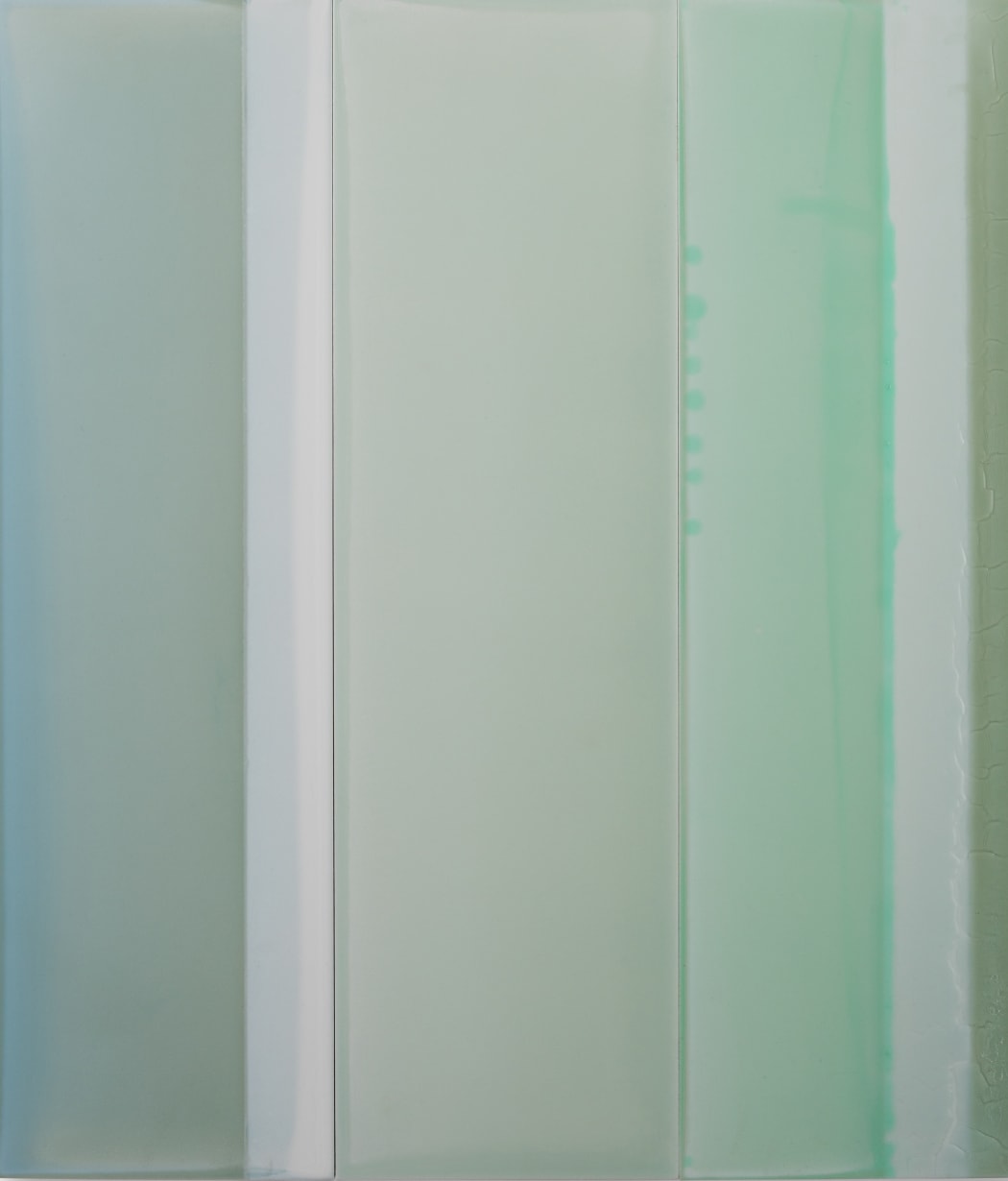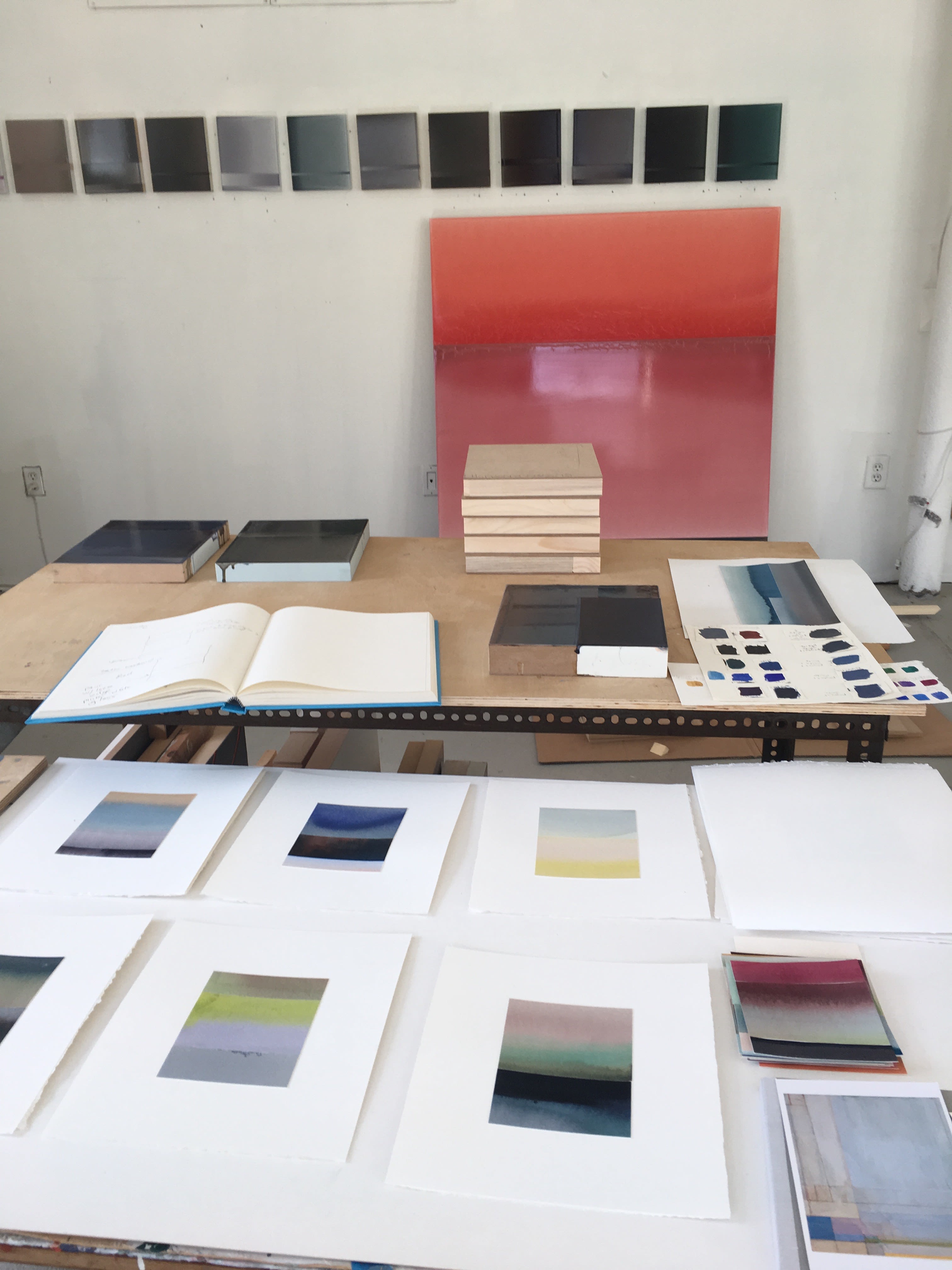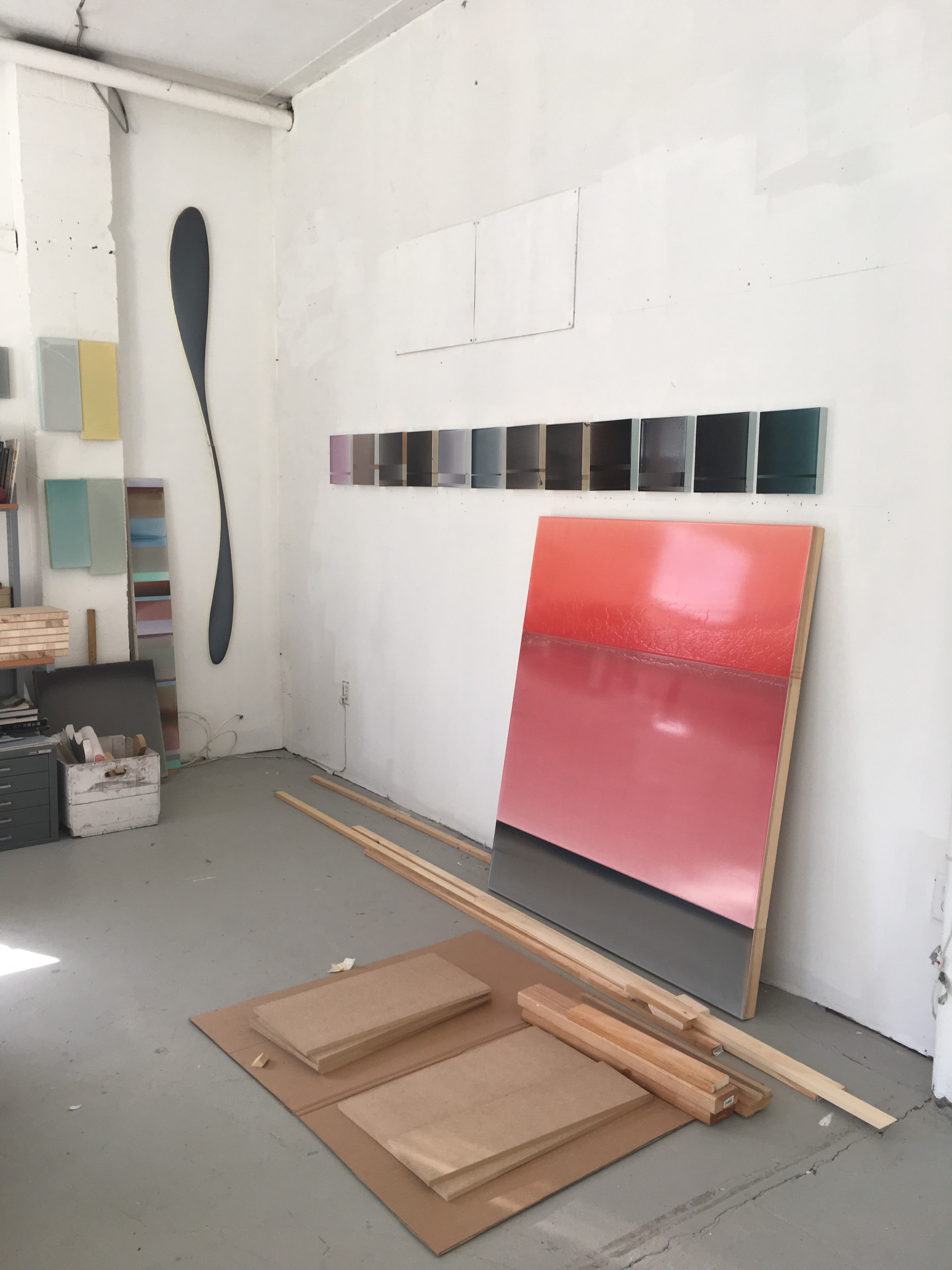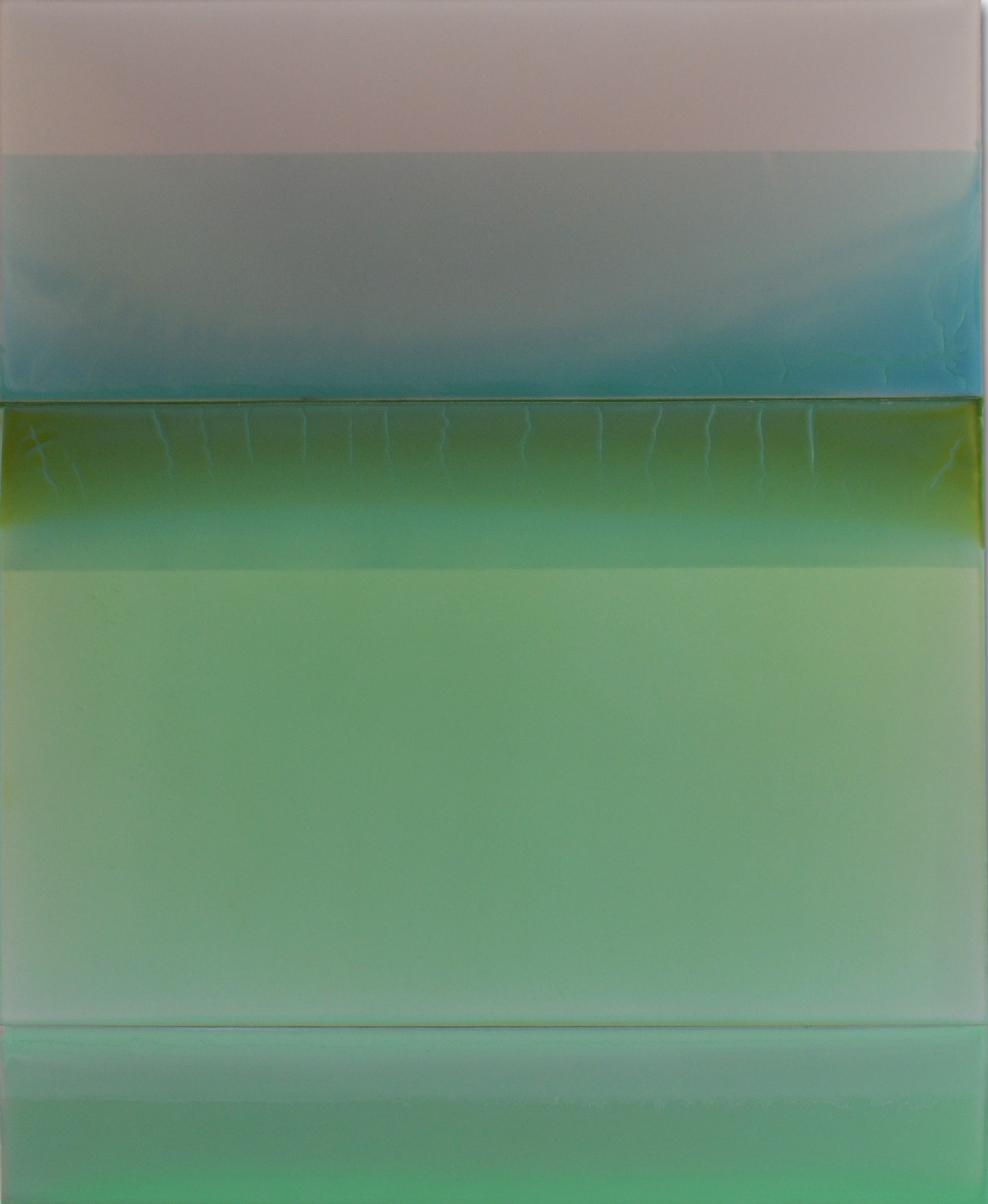
Every week, we'll be sitting down with one of our gallery artists to discuss their work, process, inspiration, and stories. This week we're speaking with Susan English.

"Blue Shade"
Susan English uses observations of light in relation to objects and spaces to create colors, atmospheres and surfaces in her work. Landscapes condense into shapes of color, and she portrays those shapes by pouring layers of tinted polymer onto panels. Those layers harden with various thickness and viscosity, the pools of paint, cracks, and coagulations creating enticing surfaces that capture a delicate relationship between control and accident. These panels are then assembled into horizontal or vertical sequences to create a narrative of color, space, and light. We spoke with one of our newest artists about her break with the Studio School, balancing intention and chance, and relearning how to see in an age of distraction.
What are your earliest memories related to art?
Between the ages of 2 and 4 my family lived in Brussels, Belgium. There was a young woman who looked after us from time to time named Hele and once, after a snow storm, we built a small igloo with the snow and she put a candle inside it. It seemed very magical to me; the light and the space inside the igloo and the fact that we had created it, and also there was her foreignness (she barely spoke English) which added to the sense of mystery.
Another memory that I come back to was when I was 4 or 5. I am sitting with my mother outside, it is a sunny beautiful day and she is writing down a story that I am making up. Something about that felt so exhilarating - my story is spinning out of me and she is capturing it and making it concrete.
How and when did you start becoming an artist yourself?
In high school I knew that I wanted to be an artist. I started oil painting then and that was my medium for many years, but before that I drew and made things all the time. I continued painting in college, but ended up becoming a ceramics major. I made non-functional ceramic sculpture - that sculptural impulse has been a continual thread through my work. Right after college I set up my first "studio" in the living room of an apartment I lived in and started painting in a more serious way. I made paintings of empty rooms, generally with a single window - a sort of cross between Hopper and Bonnard. The paintings weren't great but dealt with many of the same concerns I have today. I was trying to create visceral places you could inhabit - that you could feel and experience physically. The space in the rooms and through the windows corresponding to an internal emotional space and/or relating to a moment experienced in the natural world.

Photo courtesy of the artist
What was the evolution like toward finding your current voice and visual vocabulary?
In high school I had an epiphanous moment looking at Barnett Newman's installation Stations of the Cross in the East Wing of the Smithsonian - It was the first time abstraction clicked for me. The work, in many ways, felt more real and more powerful than any representational work I had seen. It took me about 7 years to make my way into abstraction. After college I spent a couple of semesters at the New York Studio School. I remember a teacher, Bruce Gagnier, made a comment that my way of making space through basically flat planes of color was "primitive," and I realized that I didn't relate to the Studio School ethos of delineating space with a multiplicity of marks. The clarity and simplicity of an Ellsworth Kelly shape on the wall or space made through color in a Matisse resonated more for me than Cezanne's carving marks. By the time I left the NY Studio school I was making pretty reduced, abstracted landscapes. In the MFA program at Hunter my work became more minimal, completely abstract and quite sculptural, very much about surface and color. In 2003 I became a Teaching Artist at Dia:Beacon and spent a lot of time with that collection. Agnes Martin, Fred Sandback, Robert Irwin and others made a big impression on me.
What is your process like?
Any given painting consists of a sequence of panels organized either horizontally or vertically. For the most part I start with some sort of color vision or quality of atmosphere that comes either from a watercolor study or a notable color/light moment I have experienced. I start by pouring transparent layers of tinted polymer on the panel. From there, the process involves assembling and reassembling the panels, continuing to pour layers and then sometimes cutting the panels until I arrive at a sequence that feels finished, that says something, that resonates. My decisions are generally intuitive, but also the painting has a life of its own and may deviate quite a bit from the starting idea or image. I spend quite a bit of time looking and reflecting. Since there are multiple panels there are many possible versions of a given painting as I explore the different combinations of the relational aspect of colors and surfaces. I photograph along the way to keep track. Sometime a painting will come together very quickly with one or two pours and sometimes a painting will literally take months and I lose track of the number of pours, For example, the painting Blue Shade took forever and has many, many layers. The simpler works tend to be more open spatially, and the complex works have more of a narrative - both visually and emotionally. The transition from one panel to the next - what happens viscerally, spatially and color wise -is key.
What types of landscapes do you turn to most often for your work? What about them inspires you?
I have spent time every year of my life on the coast in Maine. I love this landscape, it's very pared down: ocean (not wavy - so often quiet), a thin strip of land, and sky. It has a kind of cool blue tinge to it. The water and sky are a daily light show, just extraordinarily beautiful. The fact that I have experienced this same landscape since childhood intensifies my relationship to it. And of course there is where I live, The Hudson Highlands. It wasn't a landscape I immediately loved. It's a bit gray and claustrophobic, but I have grown to love it. The light and color have certainly made their way into my paintings, which is something that I in fact have no ability to control. Often I will do something with color and realize where it came from retrospectively. I also love the vastness of Northern California and Alaska, where I've spent time.

Photo courtesy of the artist
What do you try to control in your surfaces, and what do you leave to chance?
Chance is really built into the process. When I pour a panel I am approximating the color as it will change when it dries. The poured surface takes about 24 hours to dry and in the drying process there are almost always things that happen that surprise me. Some I like, some I don't. Rarely does something come out precisely as I had imagined it. I try to control or anticipate the cracking, and I attempt to control the quality and shape of the pooled paint as I tilt the panels. Quite honestly, in the pouring process I am attempting to control as much as possible, but when I get too good at it, it might become boring! Accidents are the spice of life here!
Could you elaborate on the "immersive experience" you create for putting yourself in the path of light that you mention in your artist's statement? Why is that experience important to you and your work?
I love the quote by Annie Dillard: "I cannot cause light; the most I can do is try to put myself in the path of its beam. The secret of seeing is to sail on solar wind. Hone and spread your spirit till you yourself are a sail, whetted, translucent, broadside to the merest puff." We always exist in relation to light (and color is light essentially - there is no separation). For me that kind of immersive experience is not something I control or contrive. I do make space for it to occur; I take frequent walks, go to museums, just sit and look at my paintings, go to the river, notice the pattern of light coming through Venetian blinds. But, it happens inadvertently and then I will start to observe in a deeper way. For example, if I stare at a Morandi painting for a bit, all kinds of amazing stuff starts to happen in the intervals between the object. These small paintings of modest objects have a monumental and complex quality to the space in them. But, for me, it requires spending a little time and, in a way, letting my mind float to see it. Turning off my phone, which I do on walks and sometimes in my studio, is important. I do think that the constant ping of our phones challenges that kind of immersion. Immersive experiences are like traveling: you forget, for a period of time, your worries, responsibilities, political noise etc. and just simply see what is in front of you, whether it is in nature or in the studio or in front of a work of art. The title of Robert Irwin's book, Seeing is Forgetting the Name of the Things One Sees, describes this well.

Photo courtesy of the artist
Where do you see your work going from here?
I see my work continuing along this trajectory for awhile. From 2003-2008 I sort of rapidly transitioned through several different series, each one generating the next, but the groups of work were quite different. Before that I had worked inside of one idea for a pretty long time, since the end of graduate school in 1991. There is a lot of depth and complexity to the way I am working right now. It feels like I am inside of a deep vein with lots to continue to explore. Generally, it is an organic process: something occurs, maybe in the way a pour dries that gives me an idea of something I want to pursue further.
Explore more of Susan English's work here.

"Resemblances"
Comments
These paintings are breathtaking. And the conversation about art -- the immersive nature of light and color and the unpredictable aspects of this artist's work -- was fascinating.
